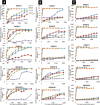Fungal endophyte-derived Fritillaria unibracteata var. wabuensis: diversity, antioxidant capacities in vitro and relations to phenolic, flavonoid or saponin compounds
- PMID: 28165019
- PMCID: PMC5292746
- DOI: 10.1038/srep42008
Fungal endophyte-derived Fritillaria unibracteata var. wabuensis: diversity, antioxidant capacities in vitro and relations to phenolic, flavonoid or saponin compounds
Abstract
Diverse fungal endophytes are rich fungal resources for the production of an enormous quantity of natural products. In the present study, 53 fungal endophytes were isolated from the bulbs of Fritillaria unibracteata var. wabuensis (FUW). Of these, 49 strains were identified and grouped into 17 different taxa, and priority was conferred to the Fusarium genus. All fungal fermented filtrates displayed antioxidant activities. The DPPH activity, total antioxidant capacities (ABTS), reduction power (FRAP), total phenolic content (TPC), total flavonoid content (TFC) and total saponin content (TSC) were evaluated using petroleum ether, ethyl acetate, n-butyl alcohol and ethanol fractions extracted from five representative fungal cultures. The last three fractions showed more potent antioxidant activity than the first fraction. Significant positive correlations were found between the compositions (TPC, TFC and TSC) and antioxidant capacities (DPPH, ABTS and FRAP). In addition, multifarious natural antioxidant components were identified from the fungal extracts, including gallic acid, rutin, phlorizin, 2,4-di-tert-butylphenol and 2,6-di-tert-butyl hydroquinone; these were determined preliminarily by TLC-bioautography, HPLC and GC-MS analysis. This study showed abundant fungal resources in FUW. Phenolics, flavonoids and saponins are crucial bioactive constituents in these abundant fungal endophytes and can be viewed as new potential antioxidant resources.
Conflict of interest statement
The authors declare no competing financial interests.
Figures





References
-
- Valko M., Rhodes C., Moncol J., Izakovic M. & Mazur M. Free radicals, metals and antioxidants in oxidative stress-induced cancer. Chem-Biol Interact 160, 1–40 (2006). - PubMed
-
- Apel K. & Hirt H. Reactive oxygen species: metabolism, oxidative stress, and signal transduction. Annu. Rev. Plant Biol. 55, 373–399 (2004). - PubMed
-
- Baxter A., Mittler R. & Suzuki N. ROS as key players in plant stress signalling. J Exp Bot 65, 1229–1240 (2014). - PubMed
-
- Ahuja N., Singh H. P., Batish D. R. & Kohli R. K. Eugenol-inhibited root growth in Avena fatua involves ROS-mediated oxidative damage. Pestic Biochem Phys 118, 64–70 (2015). - PubMed
Publication types
MeSH terms
Substances
LinkOut - more resources
Full Text Sources
Other Literature Sources
Medical
Miscellaneous

